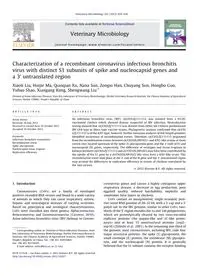
2013 Characterization of a recombinant coronavirus infectious bronchitis virus with distinct S1 subunits of spike and nu PDF
Preview 2013 Characterization of a recombinant coronavirus infectious bronchitis virus with distinct S1 subunits of spike and nu
Characterization of a recombinant coronavirus infectious bronchitis virus with distinct S1 subunits of spike and nucleocapsid genes and a 30 untranslated region Xiaoli Liu, Huijie Ma, Qianqian Xu, Nana Sun, Zongxi Han, Chuyang Sun, Hongbo Guo, Yuhao Shao, Xiangang Kong, Shengwang Liu * Division of Avian Infectious Diseases, State Key Laboratory of Veterinary Biotechnology, Harbin Veterinary Research Institute, the Chinese Academy of Agricultural Sciences, Harbin 150001, People’s Republic of China 1. Introduction Coronaviruses (CoVs) are a family of enveloped positive-stranded RNA viruses and found in a wide variety of animals in which they can cause respiratory, enteric, hepatic and neurological diseases of varying severities. Based on genotypical and serological characterizations, CoVs were classified into three genera, Alphacoronacirus, Betacoronavirus and Gammacoronavirus (Carstens, 2010). Avian infectious bronchitis virus (IBV) belongs to Gamma- coronavirus genus and causes a highly contagious upper respiratory disease, a decrease in egg production, poor eggshell quality, reduced hatchability, nephritis and sometimes false layers in chickens. CoVs contain an unsegmented, single-stranded, posi- tive-sense RNA genome of 28–32 kb, with a 50 cap and a 30 polyA tail. In the IBV genome, similar to other CoVs, two- thirds of the 50 region encodes the 1a and 1ab polyproteins, which are proteolytically cleaved by two virus-encoded replicase proteins (the papain-like and 3C-like protei- nases) into at least 15 nonstructural proteins (nsp2– nsp16) (Ziebuhr et al., 2001). In the remaining one-third of the genome, most coronaviruses, including IBV, code four major structural proteins; the spike (S) glycoprotein, the small envelope (E) protein, the membrane (M) glycopro- tein, and the nucleocapsid (N) protein. It is generally believed that the S1 subunit contains the receptor-binding Veterinary Microbiology 162 (2013) 429–436 A R T I C L E I N F O Article history: Received 10 July 2012 Received in revised form 16 October 2012 Accepted 18 October 2012 Keywords: Infectious bronchitis coronavirus Recombination event Spike glycoprotein Nucleocapsid tissue tropism Replication efficiency A B S T R A C T An infectious bronchitis virus (IBV), ck/CH/LZJ/111113, was isolated from a H120- vaccinated chicken which showed disease suspected of IBV infection. Neutralization testing showed that ck/CH/LZJ/111113 was distinct from either the Chinese predominant IBV LX4-type or Mass-type vaccine strains. Phylogenetic analysis confirmed that ck/CH/ LZJ/111113 is of the 4/91 type; however, further extensive analyses of full-length genomes identified occurrence of recombination events. Therefore, ck/CH/LZJ/111113 originated from the recombination events between ck/CH/LDL/091022- and 4/91-like strains at three switch sites located upstream of the spike (S) glycoprotein gene, and the 30 ends of S1 and nuceocapsid (N) genes, respectively. The difference of serotypes and tissue tropisms in kidneys between ck/CH/LZJ/111113 and ck/CH/LDL/091022 may have been contributed by the uptake of the S1 gene by a ck/CH/LDL/091022-like virus from a 4/91-like strain. This recombination event took place at the 30 end of the N gene and the 30 untranslated region may account for differences in replication efficiency in tissues of chickens inoculated by the two viruses. � 2012 Elsevier B.V. All rights reserved. * Corresponding author at: Division of Avian Infectious Diseases, State Key Laboratory of Veterinary Biotechnology, Harbin Veterinary Research Institute, the Chinese Academy of Agricultural Sciences, Harbin 150001, People’s Republic of China. Tel.: +86 451 85935065; fax: +86 451 82734181. E-mail address:
